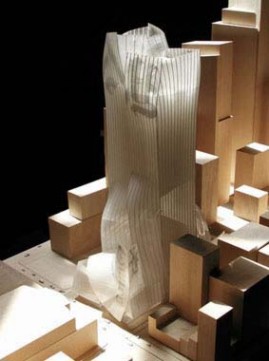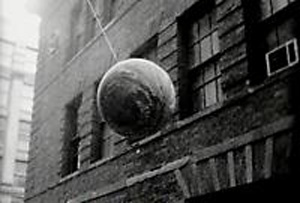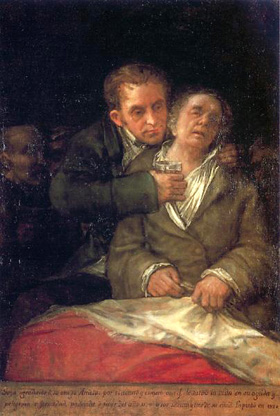Setting Standards
John Haberin New York City
Ada Louise Huxtable and The Times
Remembering Robert Hughes
Ada Louise Huxtable invented her role, as architecture critic for a great daily newspaper, and no one gets everything right the first time. The remarkable thing was her sheer dedication to defining that role. She did it for herself and others—at The New York Times, through 1982, and later at The Wall Street Journal, until her death in the new year just two months short of ninety-two.
Robert Hughes, who died six months before her, was a popularizer with standards. It drove people crazy, including some of us care about art.  Popularizing, we knew, could mean shallow—and standards an old man's rigid and unfounded opinions. We knew, too, to his credit that his demanding standards applied not just to artists, but to us. And yet I must end my appreciation of two important critics by arguing back, with an argument that extends to the current architecture critic for The Times, Michael Kimmelman, as well. It will help explain why I refuse to give up on art beyond the next big thing.
Popularizing, we knew, could mean shallow—and standards an old man's rigid and unfounded opinions. We knew, too, to his credit that his demanding standards applied not just to artists, but to us. And yet I must end my appreciation of two important critics by arguing back, with an argument that extends to the current architecture critic for The Times, Michael Kimmelman, as well. It will help explain why I refuse to give up on art beyond the next big thing.
Inventing the critic
Not that architecture had no place in shaping modern life all along. Architects and artists had insisted on it, and that possibility became Ada Louise Huxtable's theme as well. If architecture had long created both humble dwellings and vast urban spaces, Modernism gave its demanding or utopian standards new force. The Museum of Modern Art had, remarkably, its department for architecture and design right up there with painting and sculpture. She got her start there as a curatorial assistant while still in graduate school. With "Inventing Abstraction," MoMA returns now to the connections between modern artists and architects.
Architecture had also entered a broader public discourse, thanks to such figures as Lewis Mumford. Such publications as Progressive Architecture and Art in America helped make that the norm, and she wrote there, too, before joining The Times in 1963. It was about to take on a greater urgency as well with the destruction of Penn Station the next year and what Jane Jacobs called The Death and Life of Great American Cities. And Huxtable was there to deplore the first and to push strenuously for the city's Landmarks Preservation Commission thereafter. One could almost call her exacting tastes criticism with a wrecking ball, but it helps to know that she began in opposition to one. It will prove a useful point of contrast, too, to such popular writers as Robert Hughes.
One could object that she never did have a vision beyond what one title of hers called "a century of change"—and a disdain for what that century was becoming under the likes of Philip Johnson and Edward Durell Stone. One could wonder what lay beyond her praise for the Brutalism of Boston's City Hall, other than that it was uncompromising, like her. She never got over the tension between her hopes for grand designs and her hatred of high-handed fluff or authoritarian design. And it, too, helps in understanding her career. One could call it a visionary conservatism. It also helps in understanding how she felt at home both in The New York Review of Books and The Journal.
Yes, the role of full-time critic keeps evolving, and each at The Times has given it his own urgency. Paul Goldberger made it his more goal to decide what buildings work and thus, incrementally, to define a canon. That makes him more retro, at least in retrospect, but also more attuned to the range of architecture beyond any single critic's tastes. Also perhaps overdue, Herbert Muschamp focused on an emerging style after Postmodernism's retro cornices and frail skins, perhaps linking its spatial imagination to his own place in the city's gay culture. Nicolai Ouroussoff had still more love for "starchitects" (although he waffled on what Huxtable famously dubbed the Lollipop Building, now the Museum of Arts and Design). That includes his admiration for a transformation of Manhattan on behalf of the few that Huxtable surely deplored, but I learned from him as well.
Michael Kimmelman made much the same points after she died. The current critic, he quoted her on the loss of "a public architecture, or an architecture integrated into life and use." Instead "we have 'trophy' buildings by 'signature' architects, like designer clothes." Now, that criticism can easily become a forgetting of the past. Architects have long left their signatures, on behalf of wealth and power. As with Gian Lorenzo Bernini and the fountains of Rome, their acts can in fact create a new public architecture for the future.
Even the more democratic instincts of the Bauhaus came with titanic egos. And many a luxury condo now could stand a creative signature—other than the kind in a checkbook. Still, thanks to Huxtable one has to feel a chill amid overblown museum expansions and museum towers. Even worse, developers turn again and again to the same names, meaning safely established ones at that, so that even Frank Gehry had his first New York City commission only in his seventies. He did get to submit his design for The New York Times headquarters before that, but he lost. Would anyone take a chance on Maya Lin right out of Yale for a memorial today?
Architecture without buildings
Michael Kimmelman, too, was shaping his role. He was praising Huxtable as a role model—and in the process praising himself. Margaret Sullivan, the newspaper's public editor, quickly noted Kimmelman's own disdain for "buildings as baubles," like a recent addition to the Stedlijk, the museum of modern art in the Netherlands. She admired his taking the job to all five boroughs and overseas—in search of libraries and hospitals, parks and public housing, and speaking truth to power. He has been scathing and eloquent in arguing for MoMA's legacy and the former Museum of American Folk Art, but I am not so sure. This is the man who, in his tenure as chief art critic, followed star artists on personal tours of the Met.
Huxtable was still pushing for her beliefs, only weeks before her death. As Kimmelman observed, she tore into plans for the New York Public Library, as great a New York and scholarly landmark as was the Bibliothèque Nationale by Henri Labrouste for Paris. It intended to sell off the dysfunctional Mid-Manhattan Library, while adding a lending library to the main research building, eliminating stacks, moving holdings off-site. She made me see how the stacks also hold up the building, so that function and design connect in ways I never dreamed.  Not that the author of a book on Frank Lloyd Wright ignores major architects, not at all—and she urged turning the new architect, Norman Foster, loose on the Mid-Manhattan Library instead. I could not imagine Kimmelman (who has suggested retaining the branch library while selling air rights to yet another luxuriant tower that not even Wright himself has asked to build) outlining such an ambitious solution.
Not that the author of a book on Frank Lloyd Wright ignores major architects, not at all—and she urged turning the new architect, Norman Foster, loose on the Mid-Manhattan Library instead. I could not imagine Kimmelman (who has suggested retaining the branch library while selling air rights to yet another luxuriant tower that not even Wright himself has asked to build) outlining such an ambitious solution.
Now, I have a stake here, too, for I keep arguing for a critic's role as mind expander, not taste maker. And believe me, it does not pay well. In the interest of transparency, let me add that I have edited a new history of World Architecture. Richard Ingersoll, a scholar with not just an incredible knowledge of the past, is also the author of Sprawltown on suburbia, a subject that could easily extend to Wright in the city. Now Ingersoll builds on a classic textbook by the late Spiro Kostof, aiming for a more than usually global history with a greater context in urbanism and world cultures. I can only beg you to take a look and, just maybe, adopt it for your college course!
I hope, though, that I may also share with you my letter to the public editor:
Your assessment of Kimmelman's redefinition of his role is too generous. Like or dislike Huxtable, she was at least concerned for architecture and its role in altering the fabric of New York City for everyone. His lack of interest goes beyond star architects to architecture itself, he travels the world like a dilettante with time and money on his hands, and he does not seem to care what it means for most of us.
He lavished praise here once, for what turned out not to be an echo of the gallerias at the center of great European cities after all, but rather a block long office plaza for a notorious financial firm (which does not let one come in to look at the art in its lobby). Even the restaurants there were invited down by the firm, "The Times" reported elsewhere, so that its employees would have somewhere to go after a long day. Conversely, few of us have time and access to navigate by water disparate parts of the South Bronx, many remote from mass transit.
As for his smackdown of the Stedlijk, it was utterly self-involved. All he could do was to dwell on his association of it with a bathtub. I am sure he entertained himself hugely. The Times needs a genuine critic again.
Roberta Smith has done much to restore that function to the arts page, seeking out cracks in a system rewarding big-money installations. Can a critic as savvy as Kimmelman still do the same for architecture?
The shock of the old
A popularizer with standards—the combination earned Robert Hughes a huge audience. It also made him something of a rarity, at least in art, and a formidable writer. He loved long, balanced sentences, leading to equally measured one-liners. He would not settle for the simplest term when a better one would do. That high style brings him to the edge of self-parody now and again, and it can tire all too quickly. It is, however, eminently quotable, and some of the same people who found him difficult in life are still quoting him.
As for the audience, it did not come all at once, but it was not an accident. Hughes quit the half-hearted rebellion of Sydney intellectuals for London and then New York, where he secured the job of art critic with Time in 1970. At thirty-two, his only book was a memoir, and his background (beyond his undergraduate years) was as a cartoonist, not a historian. In a way, he never stopped being one. Yet he tackled the entirety of Modernism with The Shock of the New and then Francisco de Goya. Naturally he wanted to rank the players every step of the way. 
He succeeded because he knew so much and was touch with people who otherwise would never care about art—people reassured to hear that it is okay to be shocked even today. He flattered a broad distaste for art of the present, with curt dismissals of its stars. In a word, he played to a public for crusty males, an Australian's rough edges, and the assurance of high culture. That public extends to several British writers, like Christopher Hitchens and Alexander Cockburn, who died so soon before. They came to America, the land of Rush Limbaugh and Norman Mailer, for good reason.
A rarity he was, though, for popularizing art normally demands a modest forbearance. It shows in John Russell, a former chief critic of The Times with his own survey text, The Meanings of Modern Art. Notice the plural. What makes art from other centuries, other lands, and other cultures even halfway relevant to you? And when it comes to modernity, why is that art? Questions like these may not have a simple or single answer, not even from Hughes, and the pretense of high standards may dissolve the closer one looks at the art they disdain.
I, too, want to keep alive the shock of the new, much like Stanley Cavell in philosophy. And I, too, weary of art reviews as puff pieces and art theory wrongly used as an obstacle to readers, I dislike Jeff Koons and Jean-Michel Basquiat, and I appreciate an insistence that they are nonetheless perfectly sincere. For Hughes, the worst art (meaning Julian Schnabel) is always sincere, where most people take it for a fraud. Still, for all my agreements and admiration, I despise the arbitrary dismissals and male posturing, akin to the very artists he put down. It is no coincidence that an obituary compared his increasingly jowly "build" to Hemingway's, while another praised his prose for its "muscularity." Imagine talking about a woman writer's image accordingly.
I hate the easy moves from plausible observation to name calling to sweeping generalization, just as in right-wing politics—and just as with Dave Hickey, a critic who quit writing this same year because he could no longer abide contemporary art. Hughes may have reasons for his dislikes, but he has little praise for anyone past Andy Warhol at best. Gatekeepers, like Hilton Kramer or Jed Perl, come all too easily, and they make awful critics. Their purpose is to rank, with utter certainty, and not to see. I do not disguise my judgments, but I believe that criticism can explain what is going on enough to prod your interest and understanding, and you can then be trusted to form your own rankings. That kind of criticism, too, is more and more a rarity, and it is why I write.

Ada Louise Huxtable died January 7, 2013. Michael Kimmelman's appreciation appeared in The New York Times the next day and the public editor's blog posting the day after that. World Architecture: A Cross-Cultural History (Oxford University Press, 2013), by Richard Ingersoll and Spiro Kostof, was published in December 2012. Robert Hughes died August 6, 2012. I have edited my letter slightly for space and clarity. A related article looks back at other achievements and other losses in a "Best of 2012." On May 7, 2014, the New York Public Library thankfully abandoned its plans after so much public outcry and promised to focus on renovation of its Mid-Manhattan Library. It became the Stavros Niarchos Foundation Library (without Foster's help) in 2021.




